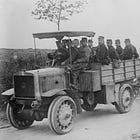'Arrested Development' of the 'Régiments d'Artillerie Lourde'
The Phantom Batteries of Plan XVII (Part IV)
The notion that the 2nd Heavy Artillery Regiment was a standard heavy artillery regiment that had yet to be fully formed calls into question some of the information provided by Plan XVII. If the peace establishment of a standard heavy artillery regiment gave it six batteries of Rimailho howitzers and six batteries of Baquet howitzers, and the 2nd Heavy Artillery Regiment already possessed six batteries of Rimailho howitzers, it follows that the remaining batteries of the 2nd Heavy Artillery Regiment should have been armed with Baquet howitzers. This view is in harmony with the information provided by the surviving war diaries of that regiment, as well as the memoirs of Joffre, Baquet and Terrail. That is to say, Joffre’s claim that ninety-six Baquet howitzers took the field at the start of the war compatible with the existence of four standard heavy artillery regiments, each of which was authorized six batteries of such weapons. At the same time, the figure of eighty-four Baquet howitzers provided by Baquet and Terrail is compatible with the mobilization of three standard regiments and one regiment that possessed but three of the six batteries of Baquet howitzers it was supposed to have. (This ‘arrested development’ theory also resolves the anomaly of the six batteries of the 2nd Heavy Artillery Regiment assigned to the Third Army being described as ‘half of the 2nd Regiment’.)
The text of Plan XVII is the only primary source that describes batteries of the 2nd Heavy Artillery Regiment as being armed with 120mm guns. All other accounts either lack information about armament or claim that the batteries in question were armed with Baquet howitzers. When combined with the frequency with which contemporary documents confused the two weapons, this minority position suggests that the information provided by the text of Plan XVII might well be the result of a typographical error. In particular, the mistake may be the result of the inadvertent replacement of the abbreviation that the text of Plan XVII used to designate the Baquet howitzer (‘120B’) with the abbreviation for the 120mm gun (‘120L’). The ease with which these two designations can be confused can be seen in the copy of Plan XVII appended to a book published in 1919. This copy, which is otherwise identical to the one that would later appear in the French official history, incorrectly identifies the six batteries of Baquet howitzers of the 1st Heavy Artillery Regiment as ‘batteries de 120L’.)[11]
Support for the ‘typographical error’ thesis is provided by two orders reprinted as annexes to the French official history, as well as by an order of battle for the Third Army as it appeared during the second week of September of 1914. The first order, which bears the date of 16 August 1914, and the order of battle, clearly shows the detachment of the 2nd Heavy Artillery Regiment (Artillerie Lourde 2) as having one group of Rimailho howitzers and one group of Baquet howitzers.[12] The second order, dated 27 August 1914, makes it clear that batteries of Baquet howitzers, as well as batteries armed with Rimailho howitzers and 120mm guns, were assigned to the Third Army at that time.[13] That the reference to the Baquet howitzer in this second order was not itself an error of transcription is indicated by the spelling out of the word ‘howitzer’ (obusier), by the descriptions of technical characteristics that follow the mention of each type of artillery piece and by the fact that the officer signing the order, General Pierre Ruffey (1851-1928), was an accomplished artillery officer who had previously taught a course on the employment of heavy artillery at the École Supérieure de Guerre.[14]
Acceptance of the ‘typographical error’ and ‘arrested development’ theories solves the conundrum of the 2nd Heavy Artillery Regiment and, in doing so, permits the completion of accurate organizational charts (both peacetime and wartime) for the five heavy artillery regiments. It also changes the appearance of the program to provide mobile heavy artillery to the field armies of France. As seen from the points of view offered by the (uncorrected) text of Plan XVII as well as the (unexplained) memoirs of Joffre, Baquet and Terrail, the mobile heavy artillery mobilized at the start of the war creates a distinct impression of hasty improvisation – the martial equivalent of a pot-luck supper. If, however, one accepts the view that the 2nd Heavy Artillery Regiment was a standard unit in the making, a certain degree of order emerges from the chaos.
Notes:
[11] Engerand, La Bataille de la Frontière, p. 196.
[12] Les Armées Françaises dans la Grande Guerre, Tome 1, Volume 2, Annex 365 and Tome 1, Volume 3, p. 1349.
[13] Les Armées Françaises dans la Grande Guerre, Tome 1, Volume 2, Annex 873.
[14] Pierre Ruffey, Cours d’Artillerie, Quatrième Partie, (Paris: Ecole Supérieure de Guerre, 1901).
This is the fourth post in The Phantom Batteries of Plan XVII. For links to the other posts in this series, please make use of the following aggregator:
To Subscribe, Support, or Share:
.







